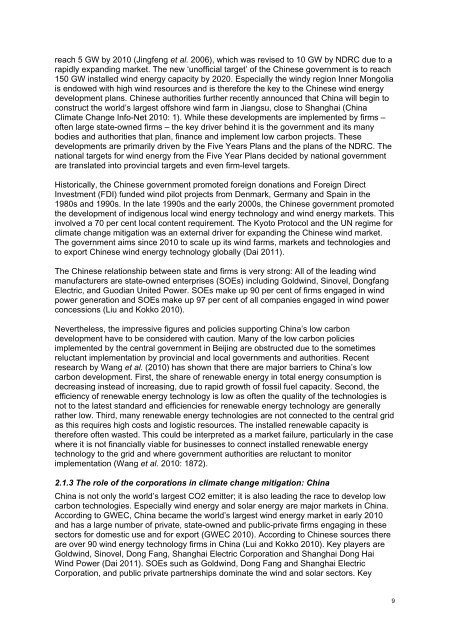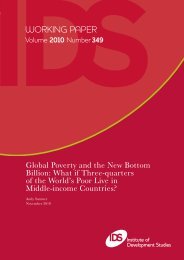IDS WORKING PAPER - Institute of Development Studies
IDS WORKING PAPER - Institute of Development Studies
IDS WORKING PAPER - Institute of Development Studies
Create successful ePaper yourself
Turn your PDF publications into a flip-book with our unique Google optimized e-Paper software.
each 5 GW by 2010 (Jingfeng et al. 2006), which was revised to 10 GW by NDRC due to a<br />
rapidly expanding market. The new ‘un<strong>of</strong>ficial target’ <strong>of</strong> the Chinese government is to reach<br />
150 GW installed wind energy capacity by 2020. Especially the windy region Inner Mongolia<br />
is endowed with high wind resources and is therefore the key to the Chinese wind energy<br />
development plans. Chinese authorities further recently announced that China will begin to<br />
construct the world’s largest <strong>of</strong>fshore wind farm in Jiangsu, close to Shanghai (China<br />
Climate Change Info-Net 2010: 1). While these developments are implemented by firms –<br />
<strong>of</strong>ten large state-owned firms – the key driver behind it is the government and its many<br />
bodies and authorities that plan, finance and implement low carbon projects. These<br />
developments are primarily driven by the Five Years Plans and the plans <strong>of</strong> the NDRC. The<br />
national targets for wind energy from the Five Year Plans decided by national government<br />
are translated into provincial targets and even firm-level targets.<br />
Historically, the Chinese government promoted foreign donations and Foreign Direct<br />
Investment (FDI) funded wind pilot projects from Denmark, Germany and Spain in the<br />
1980s and 1990s. In the late 1990s and the early 2000s, the Chinese government promoted<br />
the development <strong>of</strong> indigenous local wind energy technology and wind energy markets. This<br />
involved a 70 per cent local content requirement. The Kyoto Protocol and the UN regime for<br />
climate change mitigation was an external driver for expanding the Chinese wind market.<br />
The government aims since 2010 to scale up its wind farms, markets and technologies and<br />
to export Chinese wind energy technology globally (Dai 2011).<br />
The Chinese relationship between state and firms is very strong: All <strong>of</strong> the leading wind<br />
manufacturers are state-owned enterprises (SOEs) including Goldwind, Sinovel, Dongfang<br />
Electric, and Guodian United Power. SOEs make up 90 per cent <strong>of</strong> firms engaged in wind<br />
power generation and SOEs make up 97 per cent <strong>of</strong> all companies engaged in wind power<br />
concessions (Liu and Kokko 2010).<br />
Nevertheless, the impressive figures and policies supporting China’s low carbon<br />
development have to be considered with caution. Many <strong>of</strong> the low carbon policies<br />
implemented by the central government in Beijing are obstructed due to the sometimes<br />
reluctant implementation by provincial and local governments and authorities. Recent<br />
research by Wang et al. (2010) has shown that there are major barriers to China’s low<br />
carbon development. First, the share <strong>of</strong> renewable energy in total energy consumption is<br />
decreasing instead <strong>of</strong> increasing, due to rapid growth <strong>of</strong> fossil fuel capacity. Second, the<br />
efficiency <strong>of</strong> renewable energy technology is low as <strong>of</strong>ten the quality <strong>of</strong> the technologies is<br />
not to the latest standard and efficiencies for renewable energy technology are generally<br />
rather low. Third, many renewable energy technologies are not connected to the central grid<br />
as this requires high costs and logistic resources. The installed renewable capacity is<br />
therefore <strong>of</strong>ten wasted. This could be interpreted as a market failure, particularly in the case<br />
where it is not financially viable for businesses to connect installed renewable energy<br />
technology to the grid and where government authorities are reluctant to monitor<br />
implementation (Wang et al. 2010: 1872).<br />
2.1.3 The role <strong>of</strong> the corporations in climate change mitigation: China<br />
China is not only the world’s largest CO2 emitter; it is also leading the race to develop low<br />
carbon technologies. Especially wind energy and solar energy are major markets in China.<br />
According to GWEC, China became the world’s largest wind energy market in early 2010<br />
and has a large number <strong>of</strong> private, state-owned and public-private firms engaging in these<br />
sectors for domestic use and for export (GWEC 2010). According to Chinese sources there<br />
are over 90 wind energy technology firms in China (Lui and Kokko 2010). Key players are<br />
Goldwind, Sinovel, Dong Fang, Shanghai Electric Corporation and Shanghai Dong Hai<br />
Wind Power (Dai 2011). SOEs such as Goldwind, Dong Fang and Shanghai Electric<br />
Corporation, and public private partnerships dominate the wind and solar sectors. Key<br />
9

















